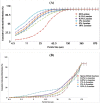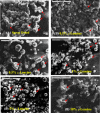Agglomerated novel spray-dried lactose-leucine tailored as a carrier to enhance the aerosolization performance of salbutamol sulfate from DPI formulations
- PMID: 29260462
- PMCID: PMC6280810
- DOI: 10.1007/s13346-017-0462-8
Agglomerated novel spray-dried lactose-leucine tailored as a carrier to enhance the aerosolization performance of salbutamol sulfate from DPI formulations
Abstract
Spray-drying allows to modify the physicochemical/mechanical properties of particles along with their morphology. In the present study, L-leucine with varying concentrations (0.1, 0.5, 1, 5, and 10% w/v) were incorporated into lactose monohydrate solution for spray-drying to enhance the aerosolization performance of dry powder inhalers containing spray-dried lactose-leucine and salbutamol sulfate. The prepared spray-dried lactose-leucine carriers were analyzed using laser diffraction (particle size), differential scanning calorimetry (thermal behavior), scanning electron microscopy (morphology), powder X-ray diffraction (crystallinity), Fourier transform infrared spectroscopy (interaction at molecular level), and in vitro aerosolization performance (deposition). The results showed that the efficacy of salbutamol sulfate's aerosolization performance was, in part, due to the introduction of L-leucine in the carrier, prior to being spray-dried, accounting for an increase in the fine particle fraction (FPF) of salbutamol sulfate from spray-dried lactose-leucine (0.5% leucine) in comparison to all other carriers. It was shown that all of the spray-dried carriers were spherical in their morphology with some agglomerates and contained a mixture of amorphous, α-lactose, and β-lactose. It was also interesting to note that spray-dried lactose-leucine particles were agglomerated during the spray-drying process to make coarse particles (volume mean diameter of 79 to 87 μm) suitable as a carrier in DPI formulations.
Keywords: Agglomeration; Dry powder inhaler; Leucine; Salbutamol sulfate; Spray-drying.
Conflict of interest statement
The authors declare that they have no conflict of interest.
Figures






Similar articles
-
Physicochemical and in vitro deposition properties of salbutamol sulphate/ipratropium bromide and salbutamol sulphate/excipient spray dried mixtures for use in dry powder inhalers.Int J Pharm. 2006 Sep 28;322(1-2):22-30. doi: 10.1016/j.ijpharm.2006.05.022. Epub 2006 May 16. Int J Pharm. 2006. PMID: 16815654
-
Co-spraying of carriers (mannitol-lactose) as a method to improve aerosolization performance of salbutamol sulfate dry powder inhaler.Drug Deliv Transl Res. 2020 Oct;10(5):1418-1427. doi: 10.1007/s13346-020-00707-6. Drug Deliv Transl Res. 2020. PMID: 31933129 Free PMC article.
-
Development of a novel dry powder inhalation formulation for the delivery of rivastigmine hydrogen tartrate.Int J Pharm. 2016 Mar 30;501(1-2):124-38. doi: 10.1016/j.ijpharm.2016.01.066. Epub 2016 Feb 1. Int J Pharm. 2016. PMID: 26836711
-
Spray-Dried PulmoSphere™ Formulations for Inhalation Comprising Crystalline Drug Particles.AAPS PharmSciTech. 2019 Feb 7;20(3):103. doi: 10.1208/s12249-018-1280-0. AAPS PharmSciTech. 2019. PMID: 30734187 Review.
-
Leucine as an excipient in spray dried powder for inhalation.Drug Discov Today. 2021 Oct;26(10):2384-2396. doi: 10.1016/j.drudis.2021.04.009. Epub 2021 Apr 17. Drug Discov Today. 2021. PMID: 33872799 Review.
Cited by
-
Development of Remdesivir as a Dry Powder for Inhalation by Thin Film Freezing.Pharmaceutics. 2020 Oct 22;12(11):1002. doi: 10.3390/pharmaceutics12111002. Pharmaceutics. 2020. PMID: 33105618 Free PMC article.
-
Puerarin dry powder inhaler formulations for pulmonary delivery: Development and characterization.PLoS One. 2021 Apr 13;16(4):e0249683. doi: 10.1371/journal.pone.0249683. eCollection 2021. PLoS One. 2021. PMID: 33848310 Free PMC article.
-
A review on chitosan and its development as pulmonary particulate anti-infective and anti-cancer drug carriers.Carbohydr Polym. 2020 Dec 15;250:116800. doi: 10.1016/j.carbpol.2020.116800. Epub 2020 Aug 18. Carbohydr Polym. 2020. PMID: 33049807 Free PMC article. Review.
-
Probing Critical Physical Properties of Lactose-Polyethylene Glycol Microparticles in Pulmonary Delivery of Chitosan Nanoparticles.Pharmaceutics. 2021 Sep 29;13(10):1581. doi: 10.3390/pharmaceutics13101581. Pharmaceutics. 2021. PMID: 34683876 Free PMC article.
-
Moisture-Resistant Co-Spray-Dried Netilmicin with l-Leucine as Dry Powder Inhalation for the Treatment of Respiratory Infections.Pharmaceutics. 2018 Dec 1;10(4):252. doi: 10.3390/pharmaceutics10040252. Pharmaceutics. 2018. PMID: 30513738 Free PMC article.
References
-
- Zeng XM, Martin GP, Marriott, C. Particulate interactions in dry powder formulations for inhalation. CRC Press, 2001.
-
- Byron PR, Jashnam R. Efficiency of aerosolization from dry powder blends of terbutaline sulfate and lactose NF with different particle-size distributions. Pharm Res. 1990;7:881.
MeSH terms
Substances
LinkOut - more resources
Full Text Sources
Other Literature Sources

